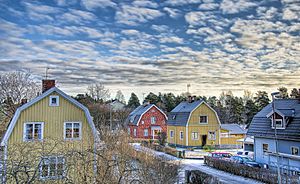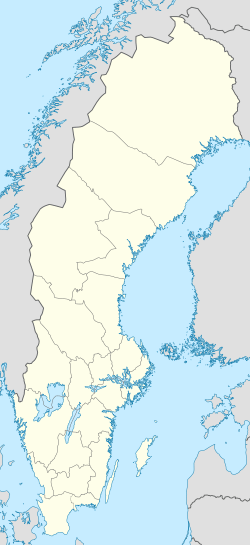Surahammar facts for kids
Quick facts for kids
Surahammar
|
|
|---|---|

Skogslund, Surahammar in January 2009
|
|
| Country | Sweden |
| Province | Västmanland |
| County | Västmanland County |
| Municipality | Surahammar Municipality |
| Area | |
| • Total | 5.49 km2 (2.12 sq mi) |
| Population
(31 December 2010)
|
|
| • Total | 6,179 |
| • Density | 1,126/km2 (2,920/sq mi) |
| Time zone | UTC+1 (CET) |
| • Summer (DST) | UTC+2 (CEST) |
Surahammar is a town in Sweden, located in Västmanland County. It is the main town, also called the seat, of Surahammar Municipality. In 2010, about 6,179 people lived there.
Contents
History of Surahammar
Surahammar has a long history, especially with making things from metal.
Early Metalworking
During the time of King Gustav Vasa, there was a place in Surahammar where people worked with metal using a large hammer. This type of workshop was called a "hammer mill." We don't know exactly when it started, but it was definitely before the year 1561.
In 1637, a new hammer mill was built by Axel Oxenstierna. This new mill had two hearths, which are like large furnaces for heating metal. It was built right where the main factory is located today.
From Railways to Cars
Later, in 1866, the factory in Surahammar started making parts for trains, like railway wheels and axles. These parts became a very important product for the factory for many years.
Towards the end of the 1800s, fewer railway materials were being sold. So, the factory's related company, Vagnfabriks-Aktiebolaget (Vabis), started looking for new things to make. They hired an engineer named Gustaf Erikson. He traveled around Europe to learn new ideas.
When he came back to Surahammar, Gustaf Erikson built Sweden's very first car! It was his own design and ran on kerosene. Vabis released its first car to the public in 1901.
Culture and Fun Things to See
Surahammar has some interesting places where you can learn about its history and culture.
Hembygdsgården
The Hembygdsgården is a special place with old buildings and historical items. It's open all year for different events and activities.
The Stone House and Historical Walk
The stone house is used for showing art. It's also the starting and ending point for a 2.5-kilometer "historical walk." Along this walk, you'll find information boards with unique old pictures that tell you about the town's past.
Museums to Explore
- The Golden Wheel MC Museum: This museum has many motorcycles and bicycles. It also has a working copy of Sweden's first car, Gustaf Eriksson's carriage from 1897! The building itself has amazing paintings on its walls.
- Surahammar's Mills Museum: This museum shows you how things were made in the old factories. You can see the whole process, from raw iron to finished railway wheels.
See also
 In Spanish: Surahammar para niños
In Spanish: Surahammar para niños



